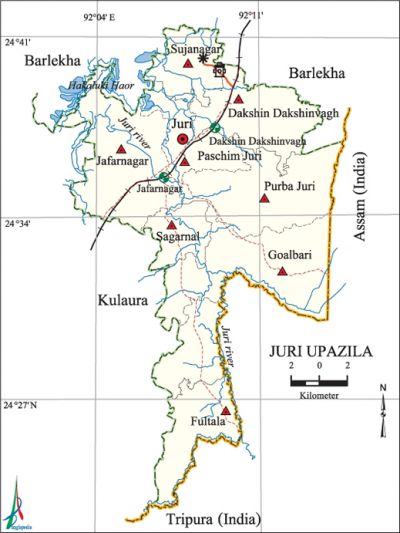Juri Upazila
Juri Upazila (maulvibazar district) area 238.44 sq km, located in between 24°22' and 24°41' north latitudes and in between 91°01' and 92°13' east longitudes. It is bounded by barlekha upazila on the north, tripura state of India on the south, Tripura and assam state of India on the east and kulaura upazila on the west.
Population 168423; male 84948, female 83475; Muslim 114748, Hindu 52667, Buddhist 630 and others 378. indigenous communities such as khasia and manipuri' belong to this upazila.
Water bodies Main river: Juri; Hakaluki Haor, Ragnachhara, Putichhara, Kawlichhara Kuiachhara canals and Chalta, Tural, Pingla and Garkuri beels are notable.
Administration Juri Upazila was formed on 26 August 1984.
| Upazila | ||||||||
| Municipality | Union | Mouza | Village | Population | Density (per sq km) | Literacy rate (%) | ||
| Urban | Rural | Urban | Rural | |||||
|
- |
8 |
92 |
144 |
- |
168423 |
706 |
- |
39.79 |
| Union | ||||
| Name of union and GO code | Area (acre) | Population | Literacy rate (%) | |
| Male | Female | |||
|
Goalbari 29 |
7835 |
10078 |
10059 |
36.09 |
|
Dakshin Daskinvagh 31 |
8385 |
13463 |
13347 |
42.78 |
|
Paschim Juri 55 |
7406 |
9247 |
8878 |
42.94 |
|
Purba Juri 67 |
5636 |
7715 |
7750 |
33.50 |
|
Jafarnagar 47 |
9483 |
15468 |
14830 |
40.72 |
|
Sujanagar 77 |
5190 |
8845 |
9254 |
46.38 |
|
Sagarnal 83 |
8312 |
11248 |
11013 |
38.43 |
|
Fultala 23 |
7364 |
8884 |
8344 |
37.48 |
Source Bangladesh Population Census 2001, Bangladesh Bureau of Statistics.

History of the War of Liberation During the War of Liberation, the freedom fighters of this upazila conducted operations in different tea gardens against the Pak army and destroyed a number of culvert and bridges. On 2 and 3 December 1971, fierce battles were fought between the allied forces and the Pak army at Fultala, Sagarnal and Kapnapahar. Juri upazila was liberated on 4 December 1971.
Marks of the War of Liberation Mass killing site 1 (Jagadhari pond behind the Juri High School).
Religious institutions Mosque 170, temple 40, church 1.
Literacy rate and educational institutions Average literacy 39.79, male 44.06% and female 35.50%. Noted educational institutions: College 2, secondary school 12, primary school 70, BRAC operated School 40, kindergarten 10, madrasa 20. Educational institutions: Tayebunnesa Khanam Academy Degree College (1994), Juri High School (1994), Nayabazar Ahmadia Fazil Madrasa (1958).
Cultural organisations Library 5.
Main sources of income Agriculture 39.48%, non-agricultural labourer 12.77%, commerce 11.85%, transport and communication 1.48%, service 7.31%, construction 0.94%, religious service 0.33%, rent and remittance 2.02% and others 18.80%.
Ownership of agricultural land Landowner 37.35%, landless 62.65%.
Main crops Paddy, jute, wheat, pulse and tea.
Main fruits Mango, jackfruit, banana, orange, pineapple.
Communication facilities Pucca road 50 km, mud road 100 km.
Noted manufactories Saw mill, rice mill, tea processing factory, aluminum factory, hardboard factory, cold storage, etc.
Cottage industries Pottery, cane works, Shitalpati.
Hats, bazars and fairs Hats and bazars are 15.
Main export Paddy and tea.
Access to electricity All the unions of the upazila are under rural electrification net-work. However 15.34% of the dwelling households have access to electricity.
Sources of drinking water Tube-well 66.25%, pond 5.72%, tap 1.54% and others 26.49%.
Sanitation 29.21% of dwelling households of the upazila use sanitary latrines and 54.37% of dwelling household use non-sanitary latrines; 16.42% of households do not have latrine facilities.
Health centres Hospital 1, union health and family planning centre 6, community clinic 20. Besides, each tea garden has its own health centre for tea labourers.
NGO activities brac, asa. [Md. Abdul Mannan]
References Bangladesh Population Census 2001, Bangladesh Bureau of Statistics.
